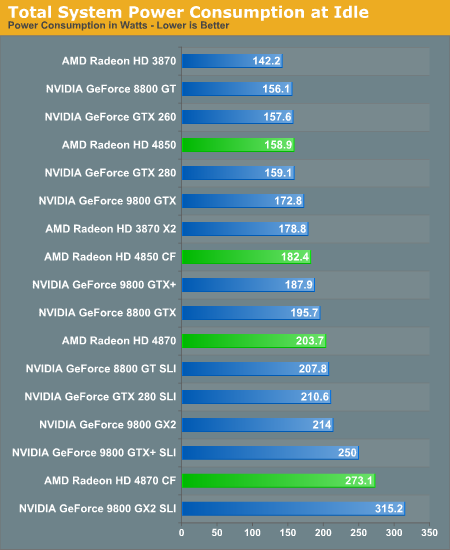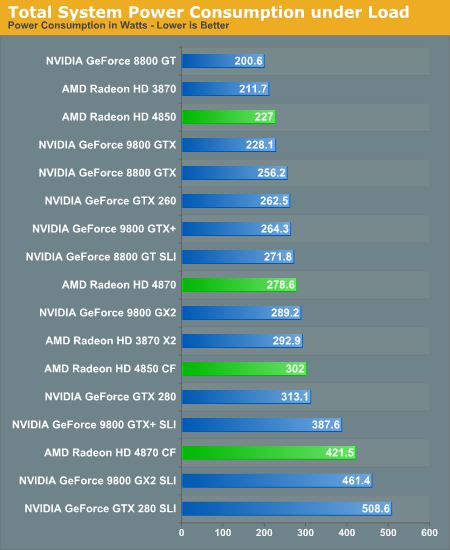The Radeon HD 4850 & 4870: AMD Wins at $199 and $299
by Anand Lal Shimpi & Derek Wilson on June 25, 2008 12:00 AM EST- Posted in
- GPUs
Power Consumption
NVIDIA's idle power optimizations do a great job of keeping their very power hungry parts sitting pretty when in 2D mode. Many people I know just leave their computers on all day and generally playing games 24 hours a day is not that great for the health. Idle power is important, especially as energy costs rise, and taking steps to ensure that less power is drawn when less power is needed is a great direction to move in. AMD's 4870 hardware is less power friendly, but 4850 is pretty well balanced at idle.

Moving on to load power.
These numbers are peak power draw experienced over multiple runs of 3dmark vantage's third feature test (pixel shaders). This test heavily loads the GPU while being very light on the rest of the system so that we can get as clear a picture of relative GPU power draw as possible. Playing games will incur much higher system level power draw as the CPU, memory, drives and other hardware may also start to hit their own peak power draw at the same time. 4850 and 4870 CrossFire both require large and stable PSUs in order to play actual games.

Clearly the 4870 is a power junky posting the second highest peak power of any card (second only to NVIDIA's GTX 280). While a single 4870 draws more power than the 9800 GX2, quad SLI does peak higher than 4870 crossfire. 4850 power draw is on par with its competitors, but 4850 crossfire does seem to have an advantage in power draw over the 9800 GTX+.
Heat and Noise
These cards get way too hot. I keep burning my hands when I try to swap them out, and Anand seems to enjoy using recently tested 4800 series cards as space heaters. We didn't look at heat data for this article, but our 4850 tests show that things get toasty. And the 4870 gets hugely hot.
The fans are kind of quiet most of the time, but some added noise for less system heat might be a good trade off. Even if it's load, making the rest of a system incredibly hot isn't really the right way to go as other fans will need to work harder and/or components might start to fail.
The noise level of the 4850 fan is alright, but when the 4870 spins up I tend to glance out the window to make sure a jet isn't just about to fly into the building. It's hugely loud at load, but it doesn't get there fast and it doesn't stay there long. It seems AMD favored cooling things down quick and then returning to quiet running.










215 Comments
View All Comments
0g1 - Wednesday, June 25, 2008 - link
In the article it says the GT200 doesn't need to do ILP. It only has 10 threads. Each of those threads needs ILP for each of the SP's. The problem with AMD's approach is each SP has 5 units and is aimed directly at processing x,y,z,w matrix style operations. Doing purely scalar operations on AMD's SP's would be only using 1 out of the 5 units. So, if you want to get the most out of AMD's shaders, you should be doing vector calculations.DerekWilson - Wednesday, June 25, 2008 - link
The GT200 doesn't worry with ILP at all.a single thread doesn't run width wise across all execution units. instead different threads execute the exact same single scalar op on their own unique bit of data (there is only one program counter per SM for a context). this is all TLP (thread level parallelism) and not ILP.
AMD's compiler can pack multiple scalar ops into a 5-wide VLIW operation.
on purely scalar code with many independent ops in a long program, AMD can fill all their units and get close to peak performance. explicit vector instructions are not necessary.
gigahertz20 - Wednesday, June 25, 2008 - link
http://www.hardwarecanucks.com/forum/hardware-canu...">http://www.hardwarecanucks.com/forum/ha...870-512m...The site above mounted an after market cooler on it and got awesome results. Either the Thermalright HR-03 GT is just that great of a GPU cooler, or the standard heatsink/fan on the 4870 is just that horrible. Going from 82C to 43C at load and 55C to 33C at idle, just from an after market cooler is crazy! I was hoping to see some overclocking scores after they mounted the Thermalright on it, but nope :(
Matt Campbell - Wednesday, June 25, 2008 - link
The HR-03GT really is that great. Check it out: http://www.anandtech.com/casecoolingpsus/showdoc.a...">http://www.anandtech.com/casecoolingpsus/showdoc.a...Our 8800GT went from 81 deg. C to 38 deg. C at load, 52 to 32 at idle. That's also with the quietest fan on the market at low speed. And FWIW, I played through all of The Witcher (about 60 hours) with the 8800GT passively cooled in a case with only 1 120mm fan.
-Matt
Clauzii - Wednesday, June 25, 2008 - link
I see no fan on that thing??! PASSIVE?? :O ??jeffreybt2 - Wednesday, June 25, 2008 - link
"Please note that this is with a single Zalman 92MM fan operating at 1600RPM along with Arctic Cooling MX-2 applied to the base."magnusr - Wednesday, June 25, 2008 - link
Does the audio part of the card support PAP? If not all blu-ray audio will be downsampled to 16/48...NullSubroutine - Wednesday, June 25, 2008 - link
I would just like to point out that the 4870 falls behind the 3870 X2 in Oblivion while in every other game it runs circles around it. To me it appears to be a driver problem with Oblivion rather than an indication of the hardware not doing well there. Unless of course the answer lies in the ring bus of the R680?orionmgomg - Wednesday, June 25, 2008 - link
I would love to see more benchmarks with the CPU OCed to at least 4.0All the CPUs you use can hit it NP.
Also, what about at least 2 GTX 280 Cards and their numbers. Noticed that you did have them in SLI cause the power comsumption comparisons had them, but you held back the performance numbers...
Lets see the top 4 cards from ATI and Nvidia compete in dule GPU (no punt intended)on an X48 with DDR3 1600 and a FSB of 400x10!
That would be really nice for the people hoe have performance systems, but may still be rocking out a pair of EVGA 8800Ultras, cause their waiting for real numbers and performance to come out - and their still paying off theye systems lol... :]
Ilmarin - Wednesday, June 25, 2008 - link
You're probably aware of these already, but I'll mention them just in case:* Page 10 (AA comparison) is malformed with no images
* Page 21 (Power, Heat and Noise) is missing the Heat and Noise stuff.
Heat is a big issue with these 4800 cards and their reference coolers, so it would be good to see it covered in detail. My 7800 GTX used to artifact and cause crashes when it hit 79 degrees, before I replaced it with an aftermarket cooler. Apparently the 4870 hits well over 90 degrees at load, and the 4850 isn't much better. Decent aftermarket coolers (HR-03 GT, DuOrb) aren't cheap... and if that's what it takes to prevent heat problems on these cards, some people might consider buying a slower card (like a 9800 GTX+) just because it has better cooling.
Anand, you guys should do a meltdown test... pit the 9800 GTX+ against the 4850, and the 4870 against the GTX 260, all with reference coolers, in a standard air-cooled system at a typical ambient temp. Forget timedemos/benchmarks... play an intensive game like Crysis for an hour or two, and see if you encounter glitches and crashes. If the 4800 cards can somehow remain artifact/crash free at those high temps, then I'd more seriously consider buying one. Heat damage over time may also be a concern, but is hard to test for.
Sure, DAAMIT's partners will eventually put non-reference coolers on some cards, but history tells us that the majority of the market in the first few months will be stock-cooled cards, so this has got be of concern to consumers... especially early adopters.